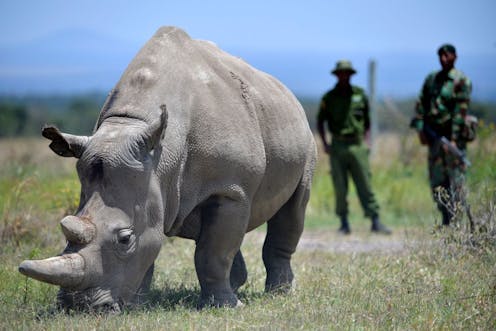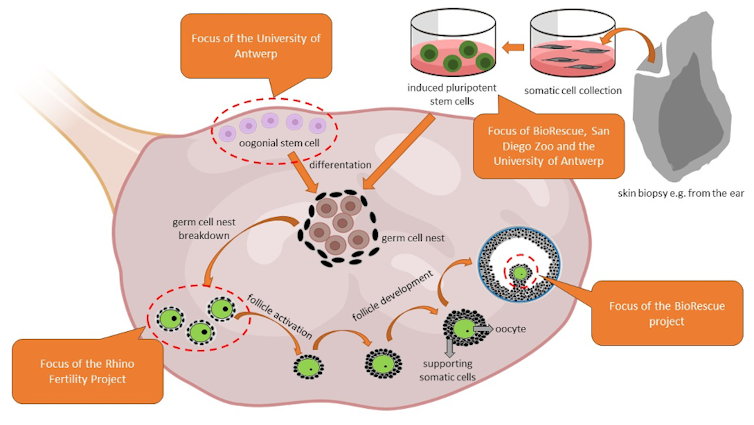
There are several parallel projects running across the world to save the northern white rhinoceros (Ceratotherium simum simum), one of Africa’s captivating and iconic wildlife species. With the death of last male in 2018 and with only two females alive, the species is functionally extinct.
The most famous of these projects is an international research consortium called BioRescue. It was founded in 2019 by a team of scientists and conservationists under the leadership of the Leibniz Institute for Zoo & Wildlife Research in Berlin, Germany.
In one of its research lines, the BioRescue team collects mature eggs – scientifically called oocytes – from one of the only two northern white females. They reside in Kenya’s Ol Pejeta Conservancy, a privately run wildlife sanctuary. These eggs will be fertilised with frozen sperm that were collected from several northern white male rhinos before their death.
The two remaining females, Najin and Fatu, are not capable of delivering offspring anymore. Najin’s back legs are too weak to carry a pregnancy and Fatu has problems with her uterus. Therefore, the resulting embryos from the fertilised eggs will be transferred into surrogate mothers.
The most suitable surrogate mother would be a southern white rhino as it is the closest related species. But, placing a northern white rhino embryo in a southern white female rhino isn’t an easy task. However, there was promising news in May 2023. Next to the addition of five more northern white embryos – which brings the total to 29 – two wild southern white rhinos were identified as suitable surrogates, as they can still get pregnant and are able to carry the pregnancy through.
Read more: The case for introducing rhinos to Australia
The goal of producing a new northern white rhino calf now seems more realistic than ever before.
Sometimes people question the funding and effort spent on one species, but the science behind the rhinoceros story is much bigger. Any species going extinct has huge consequences on the ecosystem, and people’s survival depends on resources provided by this same ecosystem. As a recognisable, impressive and majestic animal, rhinos certainly have a role as a flagship of conservation efforts.
Further, joint efforts on one species can provide scientific knowledge that allows for a multi-species conservation approach. These techniques would not only save the northern white rhinoceros, but also other rhino species, related species with a common ancestor, and all other creatures in need.
Different approaches
Despite the great scientific strides made in efforts to save the northern white rhino, the success rate of embryo transplantation followed by pregnancy to term is extremely low. Parallel initiatives focusing on different conservation approaches are indispensable to ensure the future of this species.
While BioRescue is collecting matured eggs after hormonal stimulation, the Rhino Fertility Project at the University of Oxford in the UK is focusing on growing follicles, which are structures found in the ovary containing an immature egg surrounded by a few layers of supporting cells. These supporting cells provide signals and components essential for the development of the eggs. The idea is to make use of the much greater potential of the ovary by collecting the very small follicles and growing them all in a petridish in the lab.
This would bypass atresia, which is the degradation of follicles that occurs during a natural hormonal cycle. As member of this project, one of us, Ruth Appeltant, was hopeful that this method had the potential to quickly provide a vast number of in vitro-grown oocytes, or mature eggs.
Unfortunately, it became clear that the ovarian tissue of older rhinoceroses contained extremely few to no oocytes. These eggs were needed as the starting material for the project. Without eggs, there is nothing to grow. Ongoing efforts are now looking to establish ways to localise and process the few remaining follicles in old ovarian tissue.

This bottleneck led us to the area of stem cell technologies. At the Gamete Research Centre of the University of Antwerp in Belgium, our group is aiming to produce eggs outside the body from stem cells. These could be used to conserve endangered species like the rhinoceros.
The BioRescue project and a research group at the San Diego Zoo in the US are also aiming to produce artificial eggs from body cells present in tissues.
The common thread is turning cells into induced pluripotent stem cells, which are immature cells generated from mature cells, and that can in turn differentiate into eggs. In fact, this process can transform a skin cell into an egg. The procedure has so far been completed successfully in mice and could already provide a kind of precursor to oocytes in the northern white rhino.
Read more: Even if you were the last rhino on Earth... why populations can't be saved by a single breeding pair
The collection of oocytes is a really tricky process due to the technical difficulties in reaching the site of the ovaries in living animals. Advanced artificial reproductive techniques using body cells, such as skin cells, introduce a spectrum of new possibilities. Most biological samples stored to date consist of small skin samples, but not of oocytes.
A downside to this approach is the fact that scientists first need to succeed in producing stem cells in the species of interest.
At the University of Antwerp’s Gamete Research Centre, we’re not only interested in developing stem cell technologies based on induced pluripotent stem cells, but are currently establishing the in vitro gametogenesis – or “in vitro oocyte-creation” technique – based on stem cells present in the ovary. Due to a scarcity of tissues from endangered species, we are using the pig as a large animal model. This will give us more in-depth knowledge on how to approach egg creation from stem cells already present in the animal, termed endogenous stem cells.
What next?
When we do not have eggs, let’s create them. When we have stem cells, let’s use them. Researchers now know that samples of the northern white rhino individuals currently stored in biobanks have enough genetic variability to establish a viable and sustainable population.
A decade ago, we would have never imagined eggs could be produced from other cells. This is becoming a reality that gives us hope, motivation and energy to save the northern white rhino.
Ruth Appeltant receives funding from the University of Antwerp.
Rita L. Sousa receives funding from the University of Antwerp.
This article was originally published on The Conversation. Read the original article.







